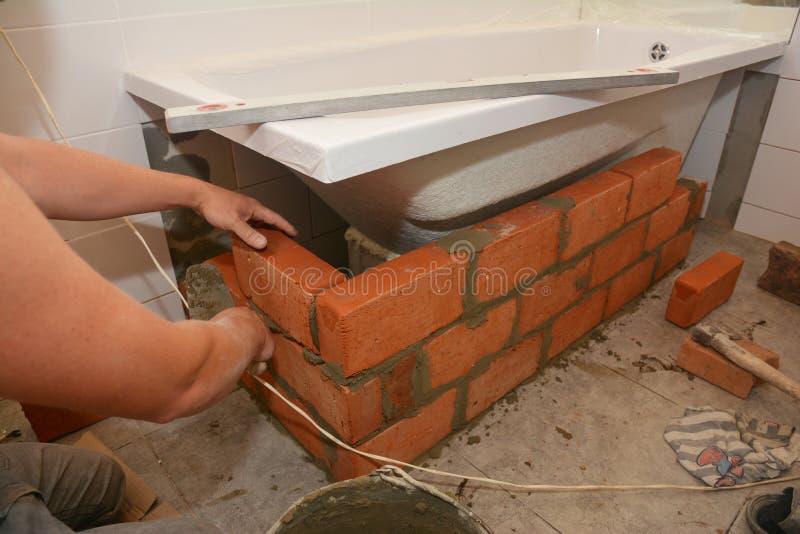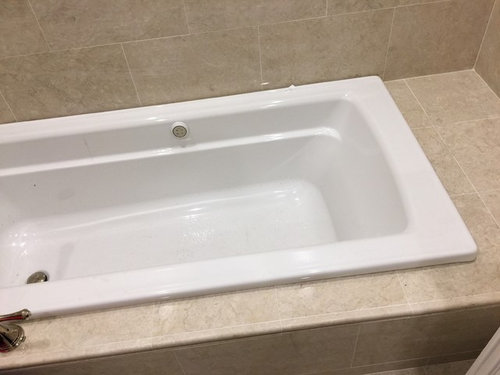A Beginner's Guide to Plumbing for Bathtub Installation
A Beginner's Guide to Plumbing for Bathtub Installation
Blog Article
Just how do you feel about Tools You Need to Install a New Bathtub ?

Setting up a bathtub isn't specifically rocket science, yet it does need strong plumbing, woodworking, as well as in some cases, tiling skills. Changing an old tub with a brand-new one is likewise a moderately tough project. If the old tub is easily available, the project can move quickly; if you need to open up a wall surface to get rid of the old tub as well as position the brand-new bath tub, the job is a lot harder. In either instance, the task is within a residence handyman's skills, although you will require an assistant to move out the old bathtub as well as embeded in the new one. Make sure you have qualified on your own for the job as well as fit attempting it. Instead of working with a service provider to take control of a halfway-completed project, it is better to consider using one prior to you begin. Possibilities are you might need a professional plumber to make tube connections.
This article will certainly help you set up a brand-new bathtub in your washroom if you have already gotten a new tub and also do not require to change the plan of your previous water pipelines.
Your tools and product list ought to comprise the following:
Planning for the Installation
First of all, the supporting structure provided with the bath ought to be fitted (if required) according to the manufacturer's guidelines. Next off, fit the taps or mixer to the tub. When fitting the tap block, it is necessary to see to it that if the faucet includes a plastic washer, it is fitted between the bath as well as the faucets. On a plastic bath, it is likewise practical to fit a sustaining plate under the taps unit to avoid stress on the bath tub.
Fit the flexible faucet ports to the bottom of both taps using 2 nuts as well as olives (sometimes supplied with the tub). Fit the plug-hole electrical outlet by smearing mastic filler round the sink electrical outlet opening, and afterwards pass the outlet via the hole in the bath. Utilize the nut supplied by the producer to fit the plug-hole. Examine the plug-hole outlet for an inlet on the side for the overflow pipe.
Next off, fit the end of the adaptable overflow pipe to the overflow electrical outlet. Afterwards, screw the pipe to the overflow face which need to be fitted inside the bathroom. See to it you utilize all of the provided washers.
Connect the catch to the bottom of the waste outlet on the tub by winding the thread of the waste outlet with silicone mastic or PTFE tape, and screw on the trap to the outlet. Attach all-time low of the overflow tube in a comparable manner.The bathroom need to now be ready to be fitted in its final setting.
Removing Old Taps
If you need to change old faucets with new ones as a part of your installation, after that the first thing you must do is detach the supply of water. After doing so, switch on the faucets to drain pipes any type of water staying in the system. The process of getting rid of the existing taps can be quite bothersome due to the limited access that is frequently the situation.
Utilize a container wrench (crowsfoot spanner) or a tap tool to undo the nut that links the supply pipelines to the taps. Have a fabric all set for the staying water that will come from the pipes. When the supply pipelines have been eliminated, make use of the same device to loosen up the nut that holds the faucets onto the bath/basin. You will need to quit the solitary taps from transforming during this procedure. As soon as the taps have been removed, the holes in the bath/basin will need to be cleaned up of any old securing substance.
Prior to proceeding to fit the brand-new taps, compare the pipe connections on the old faucets to the brand-new faucets. If the old faucets are longer than the brand-new faucets, after that a shank adapter is required for the brand-new faucets to fit.
Mounting the Tub
Using the two wooden boards under its feet, place the bath tub in the required placement. The wooden boards are helpful in equally spreading out the weight of the bath tub over the area of the boards as opposed to focusing all the weight onto four small factors.
The following goal is to guarantee that the tub is leveled all round. This can be accomplished by examining the level as well as adjusting the feet on the bath tub till the spirit level reads level.
To mount taps, fit the bottom of the outermost adaptable tap connector to the appropriate supply pipeline by making a compression sign up with; then do the exact same for the other faucet.
Activate the water system and inspect all joints and also brand-new pipework for leaks and tighten them if required. Fill up the bath tub and likewise check the overflow electrical outlet and also the normal outlet for leaks.
Finally, take care of the bathroom paneling as explained in the manufacturer's instruction manual. Tiling and also securing around the bathtub ought to wait up until the bath tub has actually been made use of at least once as this will settle it into its final position.
Fitting New Taps
If the tails of the brand-new faucets are plastic, after that you will certainly require a plastic port to avoid damage to the thread. One end of the adapter fits on the plastic tail of the faucet as well as the other end offers a connection to the existent supply pipes.
If you require to fit a monobloc, after that you will require lowering couplers, which attaches the 10mm pipeline of the monobloc to the typical 15mm supply pipe.
Next off, place the faucet in the installing opening in the bath/basin making certain that the washers remain in area in between the tap as well as the sink. Safeguard the faucet in position with the maker provided backnut. When the tap is securely in position, the supply pipelines can be linked to the tails of the taps. The faucets can either be linked by using corrugated copper piping or with regular faucet adapters. The former type needs to be connected to the tap finishes initially, tightening up only by hand. The supply pipes can later be linked to the various other end. Tighten up both ends with a spanner after both ends have actually been connected.
Tiling Around the Bathtub
In the area where the bath meets the ceramic tile, it is needed to secure the accompanies a silicone rubber caulking. This is necessary as the installation can relocate sufficient to split a stiff seal, triggering the water to permeate the wall between the bathroom and also the tiling, bring about difficulties with wetness as well as possible leakages to the ceiling listed below.
You can select from a range of coloured sealants to assimilate your fixtures and installations. They are sold in tubes and also cartridges, as well as can securing spaces approximately a width of 3mm (1/8 inch). If you have a bigger space to load, you can load it with twists of soaked newspaper or soft rope. Remember to constantly fill the bath tub with water prior to sealing, to permit the movement experienced when the tub remains in usage. The sealant can split rather very early if you do not take into consideration this motion prior to sealing.
Conversely, ceramic coving or quadrant tiles can be utilized to edge the bath or shower tray. Plastic strips of coving, which are easy to use and also cut to size, are also conveniently available on the market. It is advisable to fit the ceramic tiles using waterproof or water resistant sticky and also grout.
Bathtub Installation
How Important Is A Bathtub To Your Home?
High-quality baths, showers, and other bathroom updates are necessary when considering a smart investment in your home. It’s a room that you go to every day and one that is constantly being used by guests.The bathroom is one of the top trafficked rooms in a home and also one of the most valuable in terms of home resale.
Install Piping Before Tub
You will be using your existing drain and waste vent system, but pipes required include the hot and cold water supply lines and a pipe leading to a shower head. A mixing valve and shower head are also needed. Air chambers may be required.
Position the Tub
Lower the tub into place so that the continuous flange fits against the wall studs and rests on 1’x4' or 2’x4' supports. Anchor the tub to the enclosure with nails or screws inserted through the flanges into the studs.
NOTE: Remember, bathtubs and shower stalls may require support framing. A bathtub filled with water is extremely heavy, so check building codes and framing support before installing the tub.
Assemble Drain Connections
Assemble the bathtub drain connections by connecting the tub overflow with the tub drain above the trap, not beyond it. The trap will have a compression fitting that screws over the arm of the overflow assembly.
Place a Pipe For the Shower Head
First, locate a brass female threaded winged fitting and attach it to a framing support via a screw or a nail. Then run a pipe up the wall for the shower head. Sweat or solder the other side of the brass fitting to the top of the pipe.
Attaching Hot and Cold Water Lines
Attach your water lines for both hot and cold by sweating these directly into the hot and cold ports of the mixing valve. The mixing valve will be how water enters the tub’s system, not by the pipes themselves.
Install the Spout
Extend a piece of 1/2 inch pipe, or whichever length is specified in the manufacturer’s instructions, for the tub spout. Sweat on a male threaded fitting at the end of the pipe or use a brass nipple of the proper length and a 1/2 inch cap.
NOTE: At this point you should have your rough-in plumbing work inspected before proceeding further.
Check For Leaks
Restore the water pressure and check the drain connection and the supply pipes for any sign of leaking.
estore the Bathroom Wall
Replace the wall with moisture-resistant drywall as a base for your wall covering. Seal the joints between the wall and your new tub with silicone caulk as protection against water seepage.
https://www.berkeys.com/2016/12/02/bathtub-installation-dallas/

Do you really like more info about Installing A Bathtub? Leave a remark down below. We will be pleased to hear your suggestions about this piece. Hoping to see you back again soon. For those who enjoyed reading our blog post kindly do not forget to share it. Many thanks for your time spent reading it.
Navigate plumbing issues professionally. Report this page